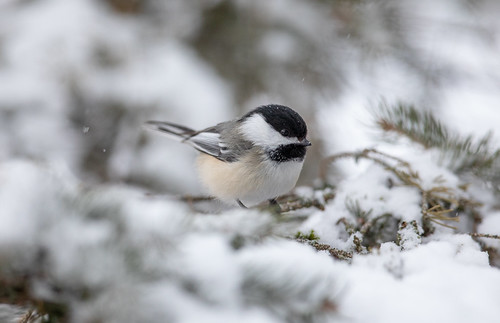At this very moment, in the predawn twilight at 7:10 am on January 30, 2023, exactly 25 minutes before sunrise, the temperature is 13 below zero and the westerly wind is blowing steadily at 11 miles per hour. I’m looking out my home office window, watching a female cardinal down in my big platform feeder, a Dark-eyed Junco feeding on the ground beneath it, and a fluffed-out chickadee pecking at a sunflower seed from a boxelder branch. At 7:13, a male cardinal chases the female off the platform feeder. At 7:15, seven juncos are on the ground and in the lilac bush. One flies into the white spruce by my window.
When cardinals are in the neighborhood, they’re invariably the first species to show up, quickly followed by the juncos. I have no idea where any of them roost at night—they're suddenly just there in the feeder, lilac bush, and ground beneath. Chickadees roost alone in their own small cavities and fly in from different directions as they each awaken.
These first birds of the day have triumphed over the long night, but survival for each is still tenuous until they’ve consumed enough calories to maintain their daytime body temperature. It's freaky to look at a chickadee and realize that just millimeters from that -13º F air temperature, its heart and the blood coursing through its tissues are a feverish 108º F. Chickadees “turn down the thermostat” at night, allowing their body temperature to drop down to the 70s or sometimes even lower. When they awaken, they shiver violently, metabolizing brown fat deposits to raise their body temp back to normal, but must quickly “stoke the furnace” with high-caloric food. When a bird succumbs to the cold, it’s usually right around the critical time after that long winter’s night when it most desperately needs food. We never see the chickadees who don’t have enough energy to raise their body temperature back to normal—they die inside their tiny roosting cavities.
By 7:20, still 15 minutes before sunrise, three more chickadees came in to grab a seed and flew off. Now a fourth is pecking at a seed while perched on the window feeder, protected from the wind. Chickadees don’t like eating near other birds, but this one has the feeder to itself. Nope—another chickadee just flew in and the first flies off too quickly for me to see whether it finished its seed, dropped it, or carried it off. I’m not worried—chickadees grasp a sunflower seed in their feet and peck a tiny hole in the shell, then take tiny bites out of the kernel even as they continue to enlarge the hole in the shell. This one had been working on the seed long enough to get most of the calories before it took off.
Most cavity roosting birds stay put later than birds sleeping on bare branches. The cavity can be several degrees warmer than the open air, warmed by the birds’ own bodies. On the coldest days, I seldom see nuthatches, woodpeckers, or starlings until several minutes after sunrise, which today is 7:35. The hungriest chickadees come earlier.
At 7:45, ten minutes after sunrise, it still looks like twilight despite the clear sky. On these bitter cold mornings while Lake Superior is still open, the sun must rise not just above the horizon but above a thick cloud of steam over the lake before any sunbeams at all reach Peabody Street.
Today the first cavity rooster other than those earliest chickadees is BB, my banded Pileated Woodpecker, at 7:48. I must see the band on his right leg to be sure he’s not a different male, but today he's holding his belly against his feet to keep them warm. He even lets go of the feeder with one foot to press his toes tightly against his tummy for a few seconds, then switches to the other foot. He's in the feeder for 5 minutes, and I get just one quick glimpse of his band. My home office window is frozen shut so I can't take photos.
A starling appears at 7:53, and my male Red-bellied Woodpecker at 8:04, followed by a Blue Jay. A flock of starlings flies in from the east at 8:07, and a female Hairy Woodpecker at 8:08. All three wintering Blue Jays are here by 8:10, so I take room-temperature peanuts outside for them and my squirrels.
At 8:13, while I'm still downstairs, I notice a bit of red in the boxelder at the far end of my driveway. BB, atop a broken limb, faces the not-quite-risen sun, body feathers all fluffed out. At 8:20, fully 45 minutes after sunrise, the sun crests the steam cloud over the lake and casts the first beams of sunlight in my yard. At that very minute, BB flies off.
Now it’s 8:30, I’ve finished my coffee, and it’s time to head off to babysit my grandson. I’m a little sad to leave before I can see for sure that my female Red-bellied Woodpecker made it through the night. I wonder what time my nuthatches will arrive, and if one or both of my Mourning Doves will show up today.
There aren't many birds for me to watch here this winter, but that just makes me pay closer attention to the ones I do see.




